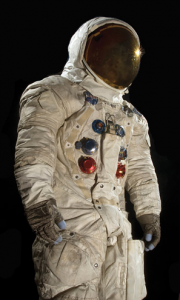 Just because they kept the astronauts of the Mercury, Gemini, and Apollo flights safe from the intense radiation, heat and pressure of space travel doesn’t mean the early NASA space suits can survive the rigors of life on Earth. There are 270 of these iconic suits remaining, and curators at the Smithsonian’s National Air & Space Museum are struggling to conserve them before they fall apart.
Just because they kept the astronauts of the Mercury, Gemini, and Apollo flights safe from the intense radiation, heat and pressure of space travel doesn’t mean the early NASA space suits can survive the rigors of life on Earth. There are 270 of these iconic suits remaining, and curators at the Smithsonian’s National Air & Space Museum are struggling to conserve them before they fall apart.
As soon as they returned to terra firma the suits began to degrade. The astronauts’ copious sweat corroded the aluminium parts and two dozen damp internal layers of nylon made a cozy home for fungus. The rubber parts turned brown and brittle like the gasket in a Moka pot you don’t use often enough (personal experience, seriously; I had to break that gasket off in pieces with a screwdriver like I was chiseling stone).
After the end of the Apollo program in the mid-1970s, NASA transferred ownership of the suits to the National Air & Space Museum, but the museum didn’t actually take possession of some of them for as long as two decades after that because NASA had loaned them to museums and exhibits around the world where they were often kept in very poor conditions. People figured if they could survive space, they’d be fine in direct sunlight, and hot, humid environments. They figured wrong, of course. Some of the newly invented polymers and materials used in the design of these suits are in fact particularly susceptible to heat, light and moisture.
One of the newly launched polymers incorporated into space suits was polyvinyl chloride. Used in the tubes that provided life support to the astronauts, PVC’s dioctyl phthalate plasticizer tends to leach to the surface of the tubing in much the same way that polycarbonate baby bottles leach their bisphenol A plasticizer into the contact liquid.
In the case of the space suits, the sticky, leaching phthalates crystallized on the surface of the PVC tubing and then began degrading into a brownish-orange compound that stained the white space suit exteriors. To avoid the discoloration, space suit conservators physically removed the PVC tubing from all the space suits and quarantined the tubing in storage.
Another problematic material in all the space suits is the rubber used in the so-called pressure bladders that sequestered the astronauts from the vacuum of space and kept their bodies at a livable air pressure, [Smithsonian conservation scientist Lisa] Young notes. Lasagne-noodle-shaped pieces of rubber combined with nylon were also placed in all the joints of a space suit to give astronauts better flexibility and motion. Unfortunately the rubber in all these components has lost its flexibility and become so brittle that the components can easily crack and deform.
The problem, Young says, is that the recipe used in the NASA space suits was a mix of natural latex rubber and synthetic neoprene rubber. Both kinds of rubber are sensitive to oxygen degradation, as well as to light, temperature, and mechanical weakening. “There were signs of degradation six months off the shelf,” she says. “But the rubber did work well enough to get the astronauts to the moon and back.” Nowadays space suit conservators monitor the rubber with CT scans. They also try to thwart damage by limiting handling and controlling environmental conditions around the garments.
The best immediate solution to the many conservation problems turns out to be just keeping the humidity level down. If the environmental moisture is below 35%, all the degradation, from the leaching plasticizers to aluminium and copper corrosion, stops in its tracks. NASM is now insisting that all museums that want to borrow the suits must adhere to strict conservation guidelines, but come June, the entire collection will be moved to new facilities at the Steven F. Udvar-Hazy Center near Washington Dulles International Airport. There the suits will be studied and conserved using the latest and greatest technologies so that they can hope to survive well into our Star Trek future.